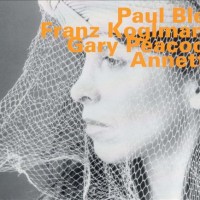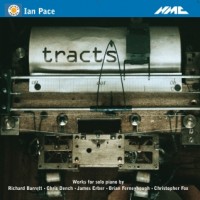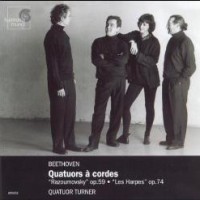Walt’s Ratatouille 5.
|
Walt Mundkowsky [April 2002.] Paul BLEY / Franz KOGLMANN / Gary PEACOCK: Annette. Bley, piano; Koglmann, flugelhorn / trumpet; Peacock, bass. hatOLOGY 564. Hat Hut‘s funding for new projects has taken a hit, so some repackaging was inevitable. This decade-old item makes an odd choice. Its tentative lyricism stands outside the Hat mission, but admirers of Bley’s most penetrating period (the 1965-68 trio output) should find Annette rewarding. Annette Peacock’s mostly fragile, haunted melodies were indispensable to the triumph of that eight-record run (after which Bley shifted to electronics for a time). The intensity in those encounters remains unique, but thanks to Koglmann this tribute is no rehash. Any wind / piano / bass setup recalls Jimmy Giuffre’s classic 1961 outfit; the sparse, disjunct textures and mix of solos, duos and trios cement the impression. (Hat unearthed two live gigs from that group, which Bley of course anchored.) The opening cut, Bley’s solo rendition of “Touching,” distills the pianist’s art — pedaling that turns notes into sculpture, leaping figures suddenly dropped, looming spaces. To the song’s sense of emotion recaptured, Bley adds his own. Nothing else reaches that plane, but the success rate is decent. Koglmann’s horn stiffens “El Cordobes” (for a charismatic bullfighter) and intensifies the bold gestures in “Cartoon,” but “Albert’s Love Theme” (a moving elegy to Albert Ayler) loses its sting. Gary Peacock (Annette’s ex-husband, as is Bley) shines on a pithy “Blood” solo, and holds “Mr Joy” together until Bley asserts the basic tune. A couple of numbers exalt decoration over sinew, but even they send us back to the primary readings. Like many Hat releases, Annette boasts exemplary sound (via Radio Bremen), especially considering the balance problems inherent with this trio. Think of it as Hat‘s ECM album (in a good way). Tracts: works for solo piano by Richard BARRETT, Chris DENCH, James ERBER, Brian FERNEYHOUGH, Christopher FOX. Ian Pace, piano. NMC D066. Nicolas Hodges and Ian Pace are formidable U.K. pianists who serve the radical music of our time. Hodges’ devotion to short-lived serialist Bill Hopkins (on col legno WWE 1CD 20042) resulted in 2000’s most enduring discovery on disc. This new CD (done in 1997) hasn’t left such a deep imprint, but Pace’s spectacular chops get a workout. Ferneyhough’s Lemma-Icon-Epigram dates from 1981 (the year Hopkins died, aged 37), and has accumulated a performance tradition. Its two long sections have little in common — after highly active and linear two-part writing (“whirlwind of the not-yet-become”), we go to “tremendous verticalized icy rigor,” still chords whose shapes are altered by “a sun passing over them” (Ferneyhough). Epigram should bring these together, but it zips past. One hears the various strands being pulled through a tiny ring, not without strain. On the page the piece seems impenetrable, but the inventive colors and range of motion actually seduce. Pace is a bit hectic and vehement; his hard-toned piano / recording doesn’t help. I incline towards James Avery’s studio taping (with a 1990 volume of Perspectives of New Music), for the way it lets the constant tempo fluctuations breathe. (Its prismatic tints are also beguiling.) The dedicatee, Massimiliano Damerini, learned the score in a few weeks — a remarkable feat — but his solutions (Arts 47216-2) are less specific. Unfamiliarity may be a factor, but the composers who follow don’t impress to this degree. Ferneyhough is often dubbed the guru of the New Complexity gang, but he has distanced himself from Barrett and Dench, citing “a form of negative frenzy” he regards as “a direct reaction to (and thus continuation of) the Beckettian ‘Endgame-impasse.'” He designates Xenakis as a more useful reference. Dench’s Topologies (1979-80) starts with the nervous scampering about the keyboard common during serialism’s heyday, but a splashier décor isn’t far off. There’s nothing strongly individual here, but Dench has an instinct for bright sonorities. At the opposite pole — ambitious scenario, slight appeal — lie Barrett’s Tract I and II (1989, 1996). I is 13:36 of rapid, thick pounding in the lower and middle registers, relieved by several Barraqué-style gaps which allow the wave of sound to decay before it resumes. After a minute of silence, II examines or retraces I from five different angles. A promising idea, if I weren’t so featureless. Scraps of late Beethoven function, in husk and lacunae,as enervated platitude. Pace offers witty expansions of nonclassical artifacts as well. Erber wrote You done torn your playhouse down (1996, after Clarence Lofton’s blues) for a Michael Finnissy salute. Childlike at first (emphatic single notes), it’s ultimately anything but. Crisp rhythms bow to the early Baroque, even Monteverdi — over rich bass ostinati, the “vocal” is declaimed in the treble. Increasingly elaborate fingerwork leads to an accelerated climax both funny and disturbing. In lliK.relliK (1991-94), Fox tries to recast Jerry Lee Lewis (“Killer”) and techno. The ‘Fifties half works better, as the parade of “licks” suggests a hall of mirrors — a “tracts of time” effect beyond the glowering Barrett. Pace’s surgically exact phrasing is part of the (intentional) joke. Imagining synth / dance sequences executed on the piano is one thing; their inhuman regularity had me wondering if the disc were groove-locked! Ludwig van BEETHOVEN: String Quartets, Op. 59 / 3; Op. 74 (“Harp”). Quatuor Turner. Harmonia Mundi HMC 905252. Since 1995, I’ve been dreaming of more Beethoven from this source. Quatuor Turner has an unusual mix (Italian and Colombian violinists, French violist, Dutch cellist), united by their chairs in Philippe Herreweghe’s Orchestre des Champs Élysées, a period-instrument band specializing in the Classical and Romantic eras. Indeed, their Op. 18 set (Harmonia Mundi HMN 911540 / 41) brought much of the thrilling scrutiny Herreweghe applies to the early choral repertory. In a smaller framework, they stressed Beethoven’s wit without scanting his lightning bolts of theatre. (No. 6’s “Malinconia,” with its seesawing sections of agitation and sadness, was deliciously nimble.) Here they move into the middle of the Middle Quartets, still rejecting the routine. In “Harp” (the curtain-raiser), finely matched articulations and tonal blend drive a subtle, flowing account. Nothing is underlined (not even the pizzicati that got Op. 74 its name), but everything registers. Jean-Philippe Vasseur’s eloquent viola leads give great pleasure. Rasumovsky No. 3 has a more revolutionary edge, and the quartet’s work on symphonic spans and research into “original performance materials” pay off. The wandering 29-bar introduction has rarely floated so purposefully, and the fugal finale ignites lots of sparks (still more than a minute behind the Alban Berg Quartet’s headlong 1979 dash). Lucidity and transparency are the bywords, carrying us to the crux of Beethovenian thought. Not that drama of a refined sort is missing. Digesting such acute decision-making requires a detailed soundstage, which is Harmonia Mundi‘s trademark. Hisses to the label, though, for not airing these 11 / 98 sessions with more dispatch. [More Walt Mundkowsky, Walt's Ratatouille]
[Previous Article:
Musicans, Among Others, On Music]
[Next Article:
The Music We Call the World: Turkey]
|


